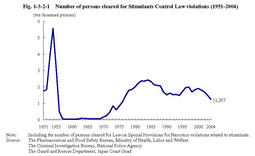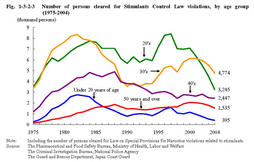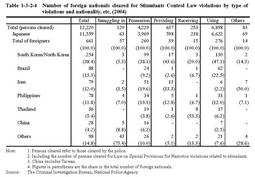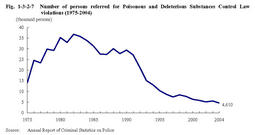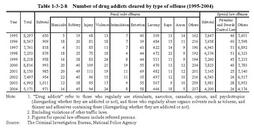| Previous Next Index Image Index Year Selection | |
|
|
1. Trend in drug offenses (1) Stimulants Control Law violations Fig.1-3-2-1 shows the number of persons cleared for Stimulants Control Law(Law No.252of1951)violations(including Law on Special Provisions for Narcotics violations related to stimulants;hereinafter the same in this Section)since1951.
Stimulants abuse began to become widespread during the chaotic postwar period,and experienced two boom periods until now.Persons cleared fell sharply after a peak over50,000in1954.As for reasons behind this trend,it has been pointed out that penal regulations were tightened in1954and1955,that clearance by police was implemented thoroughly,and that educational campaigns concerning the harmful influence of stimulants were held nationally.The number of persons cleared took an upward turn again in1970and reached24,372in1984,entering the second boom period.From then,it fell below20,000in1989and had leveled off until1994.It started to increase again in1995and came to almost20,000in1997and2000,when it entered the third boom period.However,it started to decrease in2001,and was12,397(down by16.2%from the previous year)in2004. Fig.1-3-2-1 Number of persons cleared for Stimulants Control Law violations(1951-2004) Table1-3-2-2 shows the number of persons cleared for Stimulants Control Law violations(only those cleared by the police)over the last15years by type of violations,as well as the number of those who violated the law for profit.In2004,the number of those cleared for drug use was the largest with6,898persons(56.4%),followed by those for possession with4,229persons(34.6%),and those for providing or receiving stimulants with890(7.3%). The percentage of those who violated the law for profit to total persons cleared had been stable between one and two percents every year since1991,but rose to4.2%in2004.In2004,of those who violated the law for profit,the largest was for possessing with297,followed by providing or receiving stimulants with107,and smuggling in/out with101. Table1-3-2-2 Number of persons cleared for Stimulants Control Law violations by type of violations(1990-2004) Fig.1-3-2-3 shows the number of persons cleared for Stimulants Control Law violations over the last30years by age group.Fig.1-3-2-3 Number of persons cleared for Stimulants Control Law violations,by age group(1975-2004) Table1-3-2-4 shows the number of persons cleared(only those cleared by the police)for Stimulants Control Law violations in2004,by type of violations and nationality,etc.Table1-3-2-4 Number of foreign nationals cleared for Stimulants Control Law violations by type of violations and nationality,etc.(2004) Cleared foreign nationals were661,accounting for5.4%of the total.By nationality,etc.,South/North Koreans had the largest number with254(38.4%),followed by Brazilians with88(13.3%),and Iranians with79(12.0%).By type of violations and nationality,etc.,most South/North Koreans and Brazilians were cleared for stimulants use(51.2%and70.5%,respectively),whereas the percentage of Iranians cleared for stimulants use was low(7.6%)and that of Iranians cleared for possession and providing of stimulants was high with81.0%in total.The percentage of visiting foreign nationals cleared for possession and providing of stimulants for profit was significantly higher in Iranians(44.6%)compared to other foreign nationals(Source:The Criminal Investigation Bureau,National Police Agency).Table1-3-2-5 shows the number of organized crime group members(regular and quasi-members of organized crime groups;hereinafter the same in this Section)cleared for Stimulants Control Law violations over the last15years,by type of violations.The percentage of organized group members to total persons cleared has generally been stable at around40%,and was44.4%(5,430)in2004.By type of violation,the percentage of group members was the largest every year for providing stimulants,followed by possession,which indicates that they are deeply involved in illicit sales of stimulants. Table1-3-2-5 Organized crime group members in the persons cleared for Stimulants Control Law violations by type of violations(1990-2004) (2) Narcotics and Psychotropics Control Law violations,etc. Fig.1-3-2-6 shows the number of persons cleared for Narcotics and Psychotropics Control Law violations(including Law on Special Provisions for Narcotics violations related to narcotics and psychotropics;hereinafter the same in this Section),Opium Law(Law No.71of1954)violations(including Law on Special Provisions for Narcotics violations related to opium;hereinafter the same in this Section),and Cannabis Control Law(Law No.124of1948)violations(including Law on Special Provisions for Narcotics violations related to cannabis;hereinafter the same in this Section),over the last30years.
Fig.1-3-2-6 Number of persons cleared for violations of Narcotics and Psychotropics Control Law,Opium Law,and Cannabis Control Law(1975-2004) (3) Poisonous and Deleterious Substances Control Law violations Fig.1-3-2-7 shows the number of persons referred for Poisonous and Deleterious Substances Control Law violations over the last30years.
Fig.1-3-2-7 Number of persons referred for Poisonous and Deleterious Substances Control Law violations(1975-2004) The number of persons referred for Poisonous and Deleterious Substances Control Law violations were between30,000and40,000since1980and peaked at36,796in1982.They then generally decreased below10,000since1996,to4,610(down by16.9%from the previous year)in2004.(3) Offenses by drug addicts Table1-3-2-8 shows the number of drug addicts(stimulants addicts,narcotic addicts,cannabis addicts,opium addicts,psychotropics addicts,and organic solvent addicts,etc.)cleared for offenses(penal code offenses and special law offenses(excluding violations of other traffic laws))over the last10years.By type of offense,larceny was the largest with466,followed by injury with94,and extortion with58in2004.
Table1-3-2-8 Number of drug addicts cleared by type of offense(1995-2004) |
